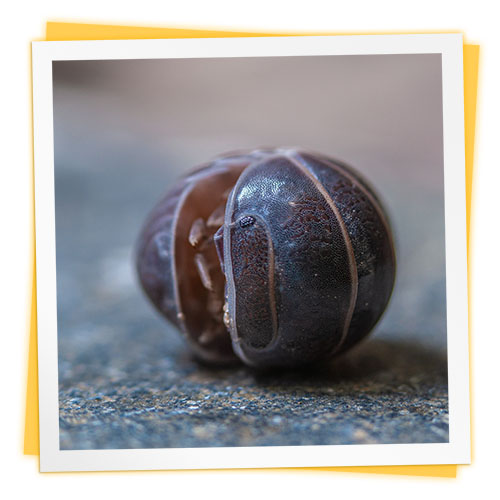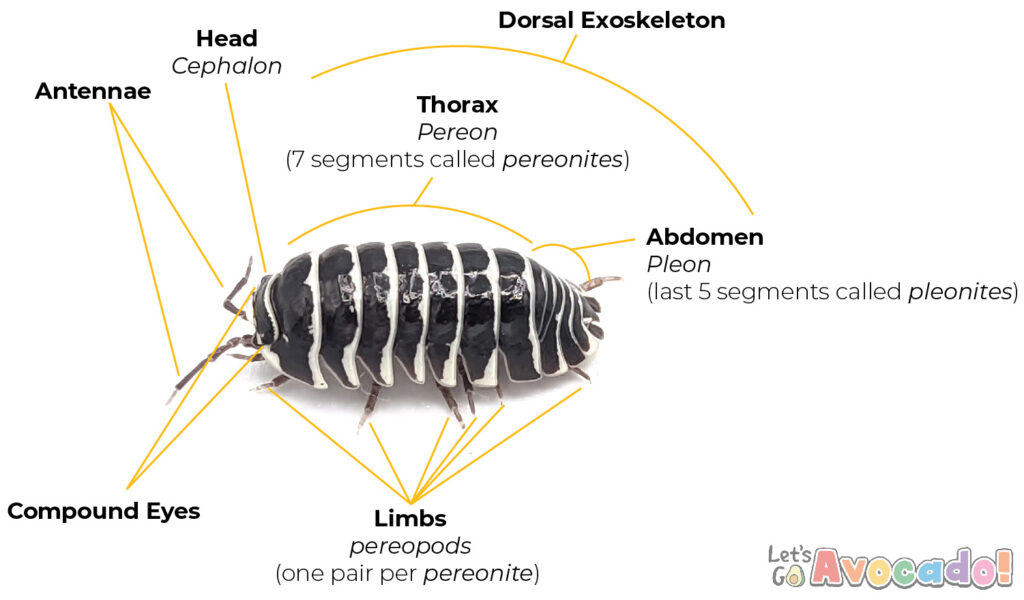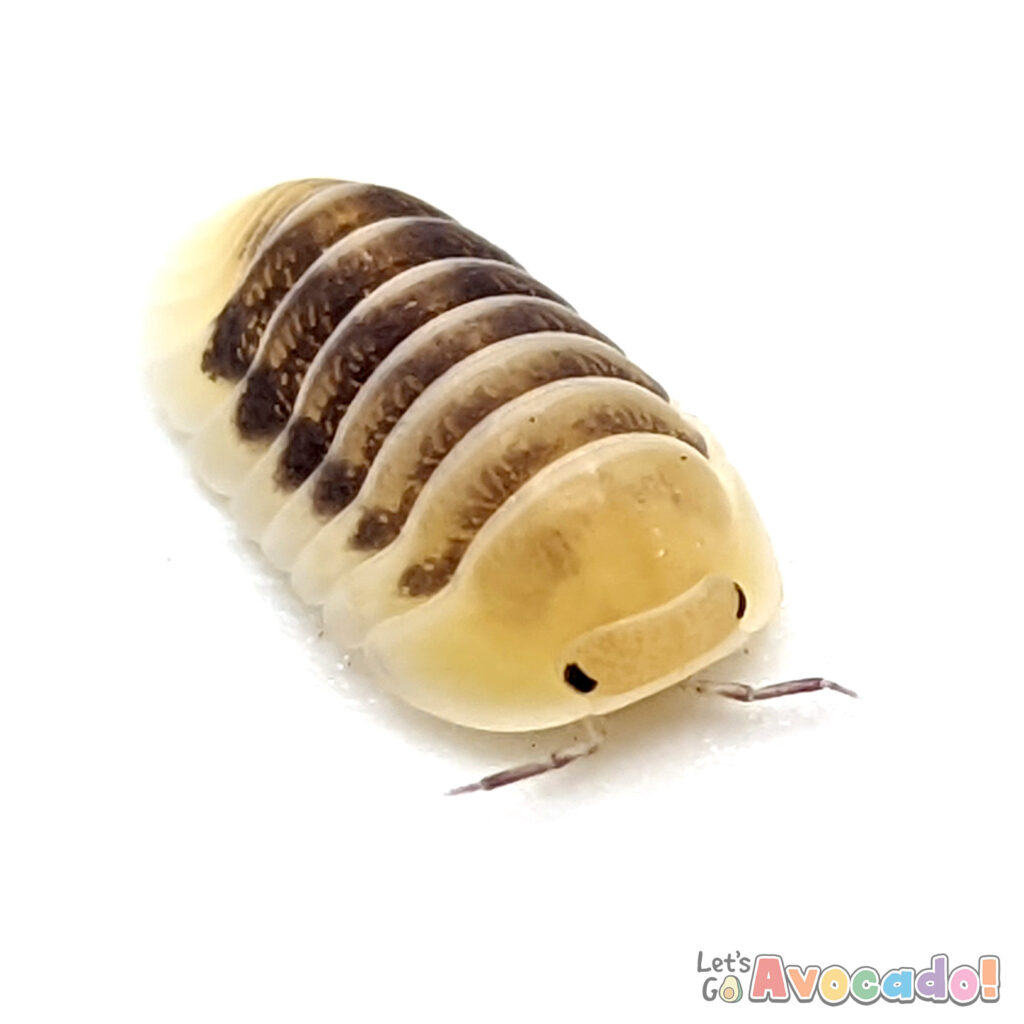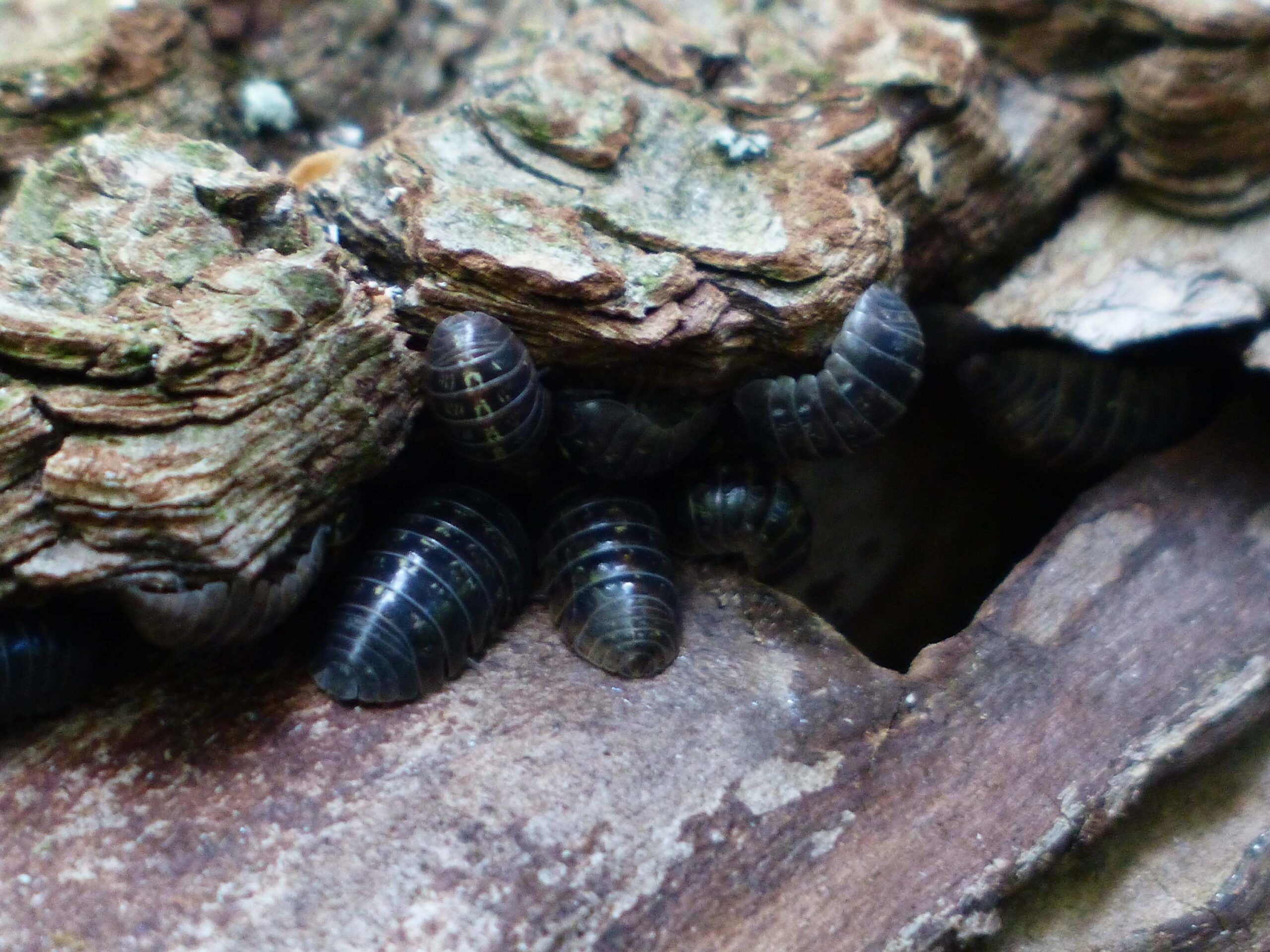This page may contain affiliate links.
Read our disclosure and privacy policy here.
Are you ready to meet some cool creepy crawlies? Get ready to learn about isopodsAn isopod is a type of small creature that belongs to the crustacean family, just like crabs and lobsters. They have a special body shape with a hard outer shell, which protects their soft insides. Learn More! They have a few other names you might have heard, like pill bugs and roly-polies. While these names are not official, they describe the quirky animals quite well: when an isopod feels afraid, it rolls up, protecting it’s soft belly from harm. Or, as scientists would say, they “conglobateAn insect ‘conglobates’ when it turns itself into a round shape. Isopods, or roly-polies, are the most commonly seen animals that conglobate when they are afraid. But they are not the only ones! Pangolins, hedgehogs, millipedes, echidna, trilobites, and various insect larvae all conglobate as well. Usually conglobation is a defense posture meant to protect vulnerable parts of their bodies. Learn More”. So, if you are scared of isopods, just remember: they are much more scared of you than you are of them.
Table of Contents
Isopods: Small Bugs, Big Jobs
Isopods are crustaceans, not insects
Now don’t go calling an isopod an insect – they’re not! These little creatures are part of the crustacean family, just like shrimps, crabs and lobsters. Unlike their more famous cousins, isopods don’t always live in the ocean. There are also terrestrial isopods. You can spot them under logs while on a hike in the forest, beneath the leaves in a local park, or even under a rock in your backyard.

Did You Know?
Did You Know?
Download Printables
AMAZING DEFENSE MECHANISM
Some isopods have evolved a defense mechanism called “conglobation”. They roll their bodies up and tuck in their legs and antennae, while protecting their soft underbellies. This is why they are also called by the cute nickname “roly-polies”.
But did you know that not all isopods are able to conglobate? An insect ‘conglobates’ when it turns itself into a round shape. Isopods, or roly-polies, are the most commonly seen animals that conglobate when they are afraid. But they are not …? Some have a different self defense mechanism called ‘tonic immobility’. This is when they stay completely still and do not react. They tuck in their legs against their underbelly and flatten their antenna over their body, without rolling into a ball. This immobility makes them seem dead, and less appetizing for some predators. Isopods are not the only animals that do this. Tonic immobility has been seen in sharks, fish, amphibians, reptiles, birds, and mammals.

Isopod Anatomy

Isopods have a unique body shape, which is often described as being oval or pill-shaped. They have a hard exoskeleton that covers their entire body except their underside, protecting them from predators. Their exoskeleton is divided into segments, like a knight’s armor. Because of this segmented design, they can still move quite well, without being any less tough! But to roll up, they still need to be flexible somewhere: that’s why their tummies are soft.
They have seven pairs of legs, each with their own little claws. They have two pairs of antennae which help them to sense their environment, and five pairs of appendages on their abdomen that help them breathe.

The head and eyes are clearly visible on this cubaris jupiter species of isopod.
Isopod Defense Mechanism
Their hard segmented armor and the ability to roll up is not the only trick up an isopod’s sleeve. It’s quite ingenious actually. When rolled up, they are not simply covered in a very hard carapace: they also look a lot like a small pebble! This is a form of camouflage, making it harder for predators to spot them.
There are some isopods that are unable to roll up into a ball. They can instead stiffen their entire bodies and play dead. This is called ‘tonic immobility’, and makes them less appetizing to predators. If you are searching for isopods in your neighborhood, you’ll probably come across both types of defense mechanisms.
Some isopods can even spray a foul-smelling liquid which makes bigger, meaner bugs think twice about messing with them. Think about it: even though we are much larger and stronger than skunks, most of us never go near them. A bad smell is am impressive defense mechanism!
Isopod's Role In The Ecosystem
So, what is the role of isopods in the ecosystem? Isopods are detritivoresDetritivores are special animals that eat dead plants and animals. They are like the cleaners of the animal kingdom. Just as you might clean up crumbs or sweep away leaves, detritivores help clean up the environment by eating things that have died. Learn More, which means that they play a vital role in breaking down dead plants and animals. They eat decomposing, decaying and moldy stuff that we would never dream of putting into our own mouths! eww! But their appetite for these unpleasant things is critically important to our ecosystemsAn ecosystem is a community of living organisms, like insects and birds, and non-living components, like water and rocks, that interact with each other in a specific area. Learn More. Just like us humans, when detritivores eat, they eventually poop! That poop is then converted into nutrients by organisms called decomposers, and these nutrients support new plant growth. Without detritivores like isopods working together with decomposers, the environment would be filled with dead and decaying matter. Nothing would be able to grow, and everything would be buried beneath dead leaves and fallen trees.
Isopods are also an important food source for other animals. Many common bird species that you might recognize, such as robins, thrushes, and jays, enjoy them as a snack when they spot them in leaf litter. Amphibians like toads and salamanders are also known to eat isopods, as well as some snakes and lizards, and even some small mammals, like shrews and mice. This is how isopods turn dead matter into energy for living organisms. This is the food web.
Where To Find Isopods
If you want to explore the fascinating world of isopods, spring is the perfect time to do so! As the weather warms up and plants begin to grow, isopods become more active and can be easily found in many outdoor environments, such as gardens, forests, and parks. Simply turn over a log, a rock, or piece of wood, and you’re likely to find them scurrying around underneath.
Level Up Your Isopod Smarts!
To take your exploration to the next level, you can even try to identify the different species of isopods that you find. There are over 5,000 terrestrial species of isopods in the world! They come in different colors, sizes, and shapes.
When you see an isopod, write down some of its defining characteristics. It’s shape, size, color pattern, behavior, and location are key features that can help you identify exactly the kind of isopod you are looking at. If you have a camera, try to get a picture as well, and keep all this information in your adventure journal.
You can use the internet to look up lists of isopod species that are local to your area, and then compare your notes with that information. With a little luck, you’ll be able to identify the exact species of isopod you found. Most areas have some species of isopod that are rare – so with luck and perseverance, you may end up catching a glimpse, and maybe even a photograph, of a really special isopod. If you do, be sure to share your find with us!
So grab a magnifying glass, a notebook, and head outside to discover the wonderful world of isopods this spring!

DISCUSSION
DISCUSSION
DISCUSSION
FOLLOW-UP TOPICS
Science Topics
Exoskeleton
Decomposers
Food Web

There’s a lot to explore right where we are, in our own neighborhoods and backyards! Join us while we get off the couch and explore the everyday wonders of nature, science, space, engineering, art, and anything else we stumble upon during on our adventures.



